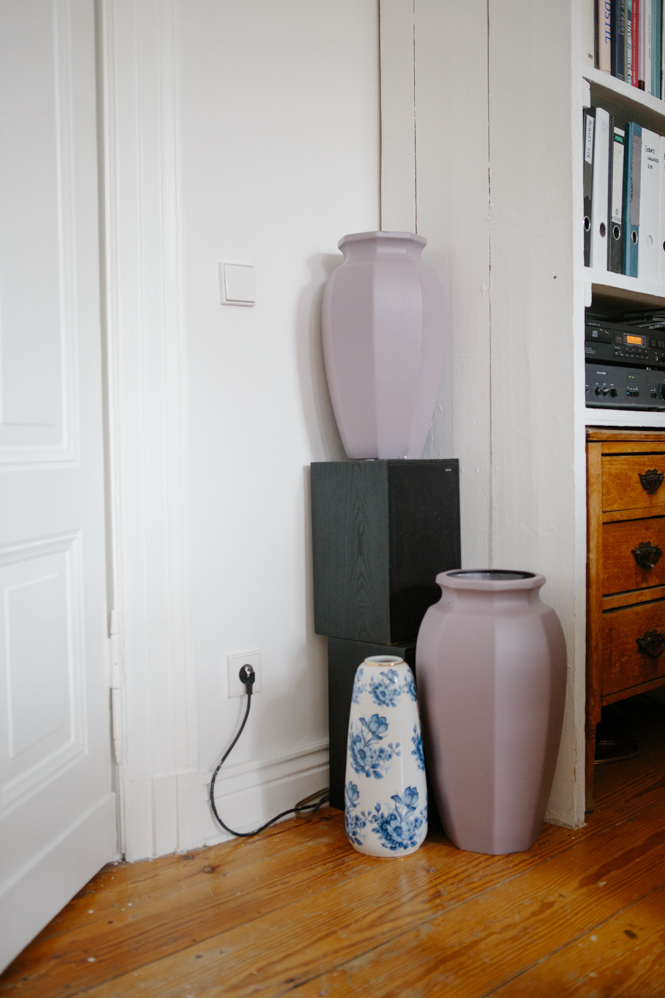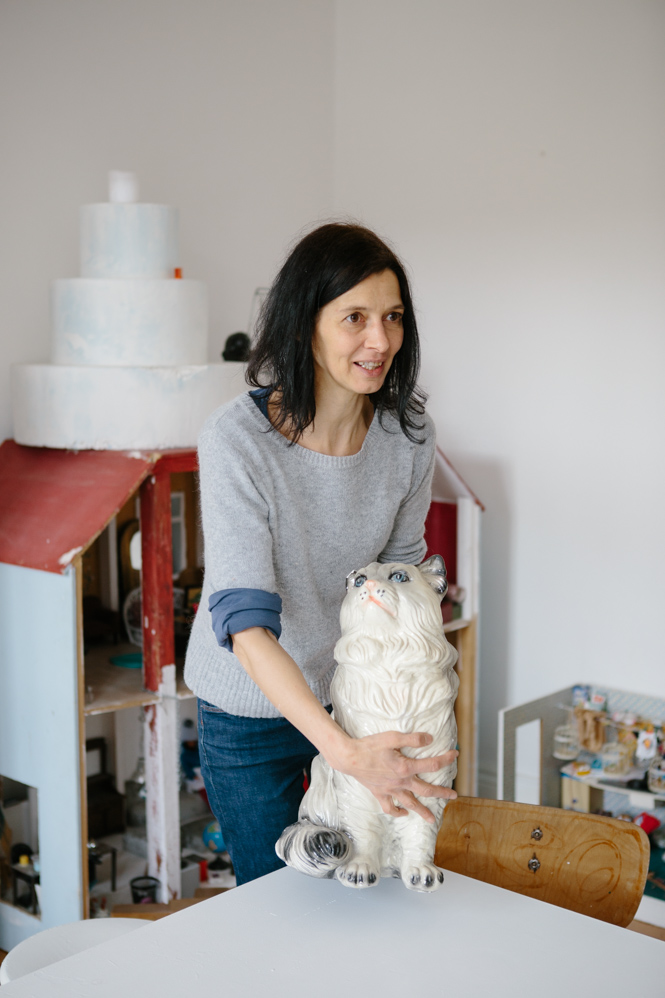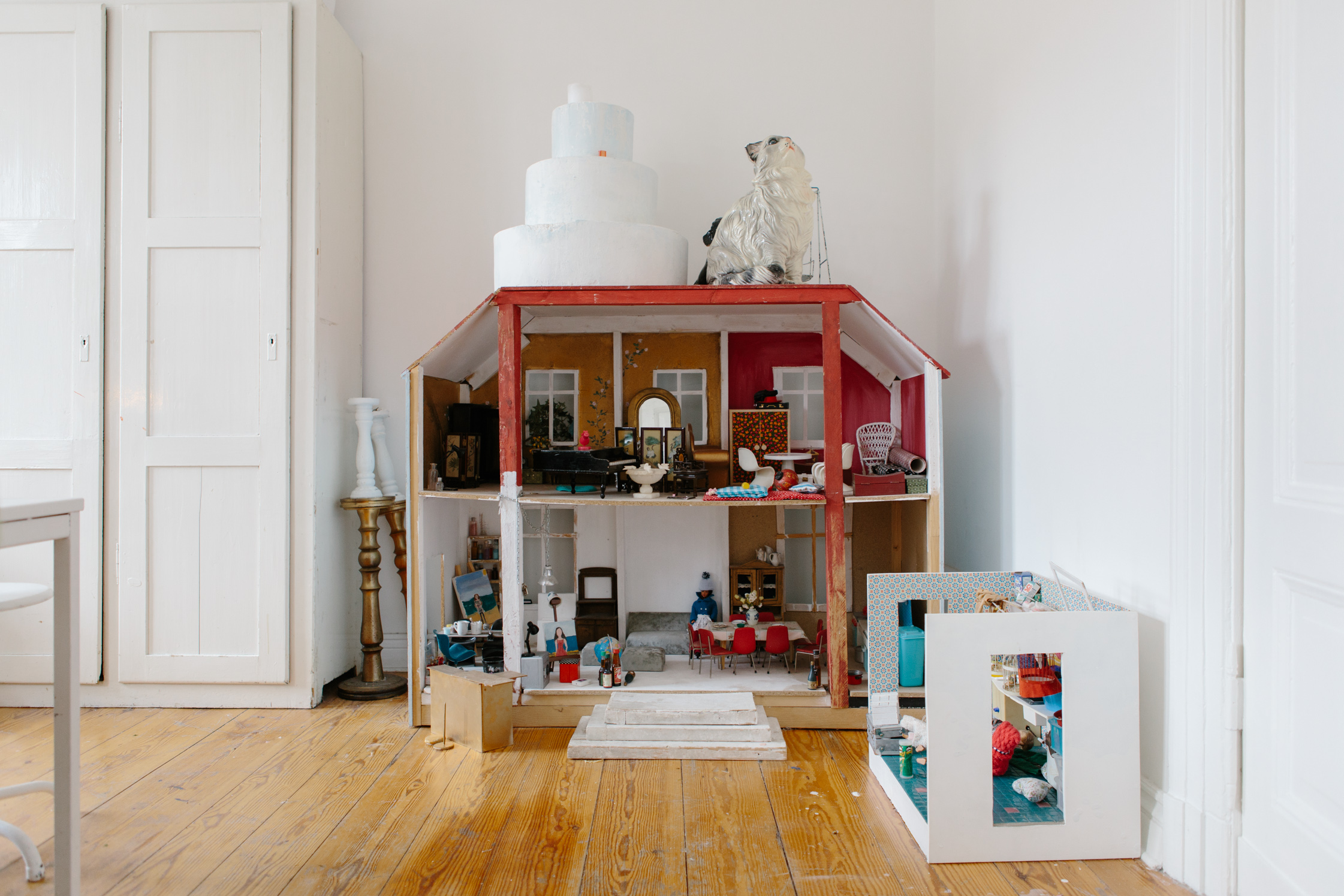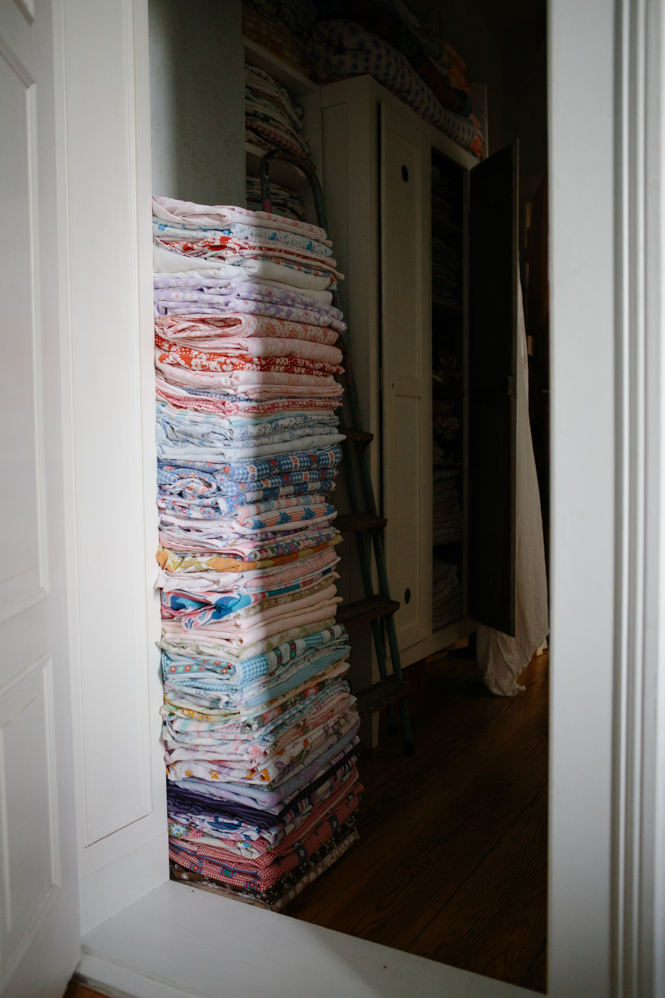Sibylle Oellerich lives in a classic altbau apartment on Berlin’s Alte Schönhauser Straße that is all sweeping windows and impressively high ceilings with perfectly imperfect molding. Everywhere you turn something catches your eye, from the bright and airy custom wallpaper in her daughter’s bedroom, to the stacks and stacks of multi-colored antique cookware lining the wall of her kitchen, to her daughters’ vintage Barbie collection.
It’s not surprising that the home has the air of a Wes Anderson film come to life – as an event and interior designer, it is Sibylle’s job to create unique displays, custom furniture, and one-of-a-kind creations for shops, hotels, and film sets. The Mitte apartment, where Sibylle lives with her 15 and 11-year-old daughters, is a mix of artist studio, with paint splotches splattered across the floor; storage for her past and upcoming installations; and a glimpse of her eccentric personality with furniture she has hand built, mementos from recent trips, and trinkets from second-hand shops around the city.
Sibylle, a native Berliner who spent her formative years in London, taught herself to make furniture in the 90s and later turned her basement storage supplies into the elaborately themed rooms of her brother’s Cookies nightclub. With a penchant for re-imagining second-hand and vintage items, Sibylle is always on the hunt for a great find, whether it’s suitcases or taxidermy for her latest project at the 25hours Hotel Berlin, or a teal vase to add to her own collection.
This portrait is part of Companion Magazine, a new project developed by FvF for 25hours Hotel.

































How did you develop an interest in second-hand and design?
Well it was the 90s and it was just all over the place. We used to have dinner parties every Wednesday, me and my boyfriend at the time, and they’d always get out of control and get really silly. We were living in a tiny flat and our ceiling was really low, and I don’t know why but people used to end up dancing on the table. So everything used to get trashed, all the furniture would just be broken the next day, and we would go to the flea market and get more. We changed the look often, that’s what we were doing. They weren’t squatted flats, but we got them really cheaply, and we just changed the way the flat looked all the time. It didn’t look the same often.
Then we got a little shop, which we called The Berlin Shipping Company, because Nick, my boyfriend, was trying to book people passages on freight ships. My part was a furniture shop, because I used to make furniture with my friend named Froggy. We didn’t sell anything, we used to sit in the shop and drink coffee and have friends over. It was really nice. So that’s how I started I suppose, by making things with Froggy and discovering how much I liked making things and how I’m actually quite good at it. This table was the first piece I made, and then I made a few more and we did sell them, but it wasn’t about selling things.
How did you shift into becoming a designer?
Do you know the Michelberger Hotel? Werner Aisslinger was the official designer, but he was doing a really straight design and they wanted it to be a lot more silly. They had seen Cookie’s little illegal club that I’d done. I haven’t done all of Cookie’s clubs, but this one was really good fun. I was dumping all my stuff into his storage space, and he was getting really fed-up with me putting all my stuff in his space. He’d given me a little corner but it wasn’t big enough and my stuff was always spreading out. Then one day he said he was going to turn it into a club and that I was to use the stuff I put in there for the club. He didn’t think of the rooms – that was my idea, because all of these things were different themes. I had this Turkish stuff for something I had done for Adidas, and then I had loads of stuff from something I had done for Universal. It was all still there with its themes – I just needed to put it into context. It was this really mad, completely scrappy project. It was still a storage space – there was still lots of stuff seriously being stored there – and then there were all these little rooms fit in. It was really nice actually.
So the Michelberger’s had seen this club, and they got me involved. Then people saw the Michelberger and got me to do their offices. I did the newest Cookie’s too. I did most of that with two other people, although that really needs to be revamped. That’s what I’m doing at the moment. I’ve been thinking I want to do a Moroccan room, because we were just in Morocco, in Marrakesh. I bought vintage postcards in Morocco, because that’s what I buy. I always pick a couple of those up.
How would you describe your style and aesthetic?
It varies so much. I guess it’s taking vintage things and trying to do something with them, and also trying to find things that I think are going to happen that people haven’t noticed yet. Finding the cheap things and doing something else with them – that’s really what I try and do. We used a lot of the industrial stuff, all those metal lamps, before they turned into a fashion. We’ve been building things out of pallet boards before it turned into a fashion. So it’s always about finding materials, and this is why it’s not just vintage, because I do love finding materials. We did a lot with the stones you find on the street, paving stones. You put five on top of each other and that’s the table, or you put three in a row and a mattress on top, and that’s the sofa.
What are your favorite places to shop for these items in Berlin?
It’s flea markets really. I love the ones that are closest to here, Arkonaplatz and Mauerpark. I love Mauerpark because it has such great food as well. I think Arkonaplatz is such a nice little market. I think they have a nice sort of in between. It’s not desperately expensive and it’s not real rubbish.
But a good flea market that I go to, which is a bit more expensive but has much nicer stuff and much more interesting stuff, is in Leipzig. I went there a few times to get stuff for the 25hours Hotel. They have odd things, they have stranger things then you can get in Berlin. They had funny little animals in glass, from laboratories. They look sort of revolting, but they’re also quite interesting and a bit exciting. They had scales for chemists, but beautiful old ones. It’s things like that, that you just don’t find so easily in Berlin. It’s so big. It’s enormous and everyone comes from all over Germany.
My complete favorite flea markets are the ones in Wedding, where if you do find something nice it only costs 50 cents because you are the only person in the whole area who would even dream of buying it. There’s a flea market at Franz-Neumann-Platz. It’s complete trash and it’s my absolute favorite. The ones that have rubbish go there, the ones who have smarter stuff go to other flea markets. But then it’s people selling their granny’s stuff as well, so sometimes you do find some really great things and if you do, they think it’s granny’s rubbish. At Arkonaplatz it would be expensive, but I do think about this very seriously, and think “Wow, I just managed to save three euros because I paid four instead of seven.” I like that, it’s fun. I quite like when things are a little chipped or broken. All the ones for me, not for work, but mine all have little chips. So it’s the right flea market for me personally.
How would you describe Berlin’s aesthetic?
It’s changed a bit. At the moment it’s very mid-century. Mid-century trash. I guess it’s glorified trash or smart trash. But then there’s Soho House, but that’s really English, and it was made by English people. I think it’s great. I like a lot of the things they have. I like the tassels on the sofa, and they are making furniture that I really like and that I am really into. There’s this look that’s been going around in my head for a long time, and I can’t get it out because there’s nowhere I can do it, but they’ve done a bit of it.
There was this shop in the 70s called BiBa in London. It was an absolute phenomenon. It was the most absolutely beautiful shop ever, all painted black. This was the first place that had counters with make-up you could test, so girls used to go in there and do their make-up for the day and then go to work. It went bust after a year and a half, and it was a great big department store. I’m also quite into this tassely 70s look. I don’t think it’s actually been done. It’s starting to be done, because palms are in again, and they weren’t for a long time. I’ve been wanting to do that sort of 70s stuff. I love it at the moment. I was going to do a room in Michelberger like this and then I didn’t get time to do it. We did it in Cookies a little bit upstairs, but we haven’t finished with that look yet and I’ve been wanting to.
You grew up in London and moved back to Berlin in the 90s. How do you like living in the neighborhood?
I would never move to Mitte if I was younger, but I’ve been here for so long. One of my best friends is my neighbor upstairs. There are also some other really good friends that live upstairs that I’ve know since I moved to Berlin. We moved here together on purpose. But we moved here ten years ago when Mitte was still quite good fun and Alte Schönhauser Straße was pretty empty. So if I was to move away from here now I’d be moving away from my friends. Also, my kids go to school here. In fact I couldn’t move away, because my kids wouldn’t come with me.
Are there any interiors in Berlin that you think are really well done?
I think there are lots. I like The Barn, on Schönhauser Allee. I think that look is really good. It has been been done a few times now, but it’s well done and it’s the kind of thing that I used to like doing.
Anywhere else, for style?
I like the toilets at the Neue Odessa. That’s a little bit because a friend of mine, Jörg Schumann, made them. You can move the mirrors or the doors and I like that a lot. I work with him sometimes, and I love working with him because we always have great ideas together. We always do silly stuff.
I haven’t been to any of the new bars or clubs. If I hadn’t seen places, I used to actually go on a tour just to see what was happening, find someone to go out with and go and look at six places in one night. I haven’t done it in a while. I liked things like KingSize when it opened but that’s old now.
A lot of the stuff I used to really like, and I still like, would be like a restaurant looking like a Swiss chalet, and you’d just be being silly. That’s what Berlin does, or that’s what some of the vintage that is quite good was doing. It would play with the look. And it’s what I was doing as well, putting that silly spin on it. The Adidas shop 74 has a little heart in the garden, and I made that, and I made that in the Michelberger hotel as well. It’s just a silly little touch, there’s a lot of humor in there. But I don’t know where the look is going at the moment; I can’t quite see it, and it’s worrying me slightly. What is happening now is things like 25hours with that mixing. I like some of it, but I think a lot of it is very constructed.
What I like about Soho House is that it’s really opulent, and it really goes over the top in everything it does. The designers were really brave to use those floral patterns all over the place at a time when it wasn’t cool yet. I mean it was Soho House that made it ok to use that in Germany. So I think it’s quite fun.
Sibylle it has been great to hear about your innovative projects and life in Berlin.
Interview & Text: Katherine Sacks
Photos: Philipp Langenheim
